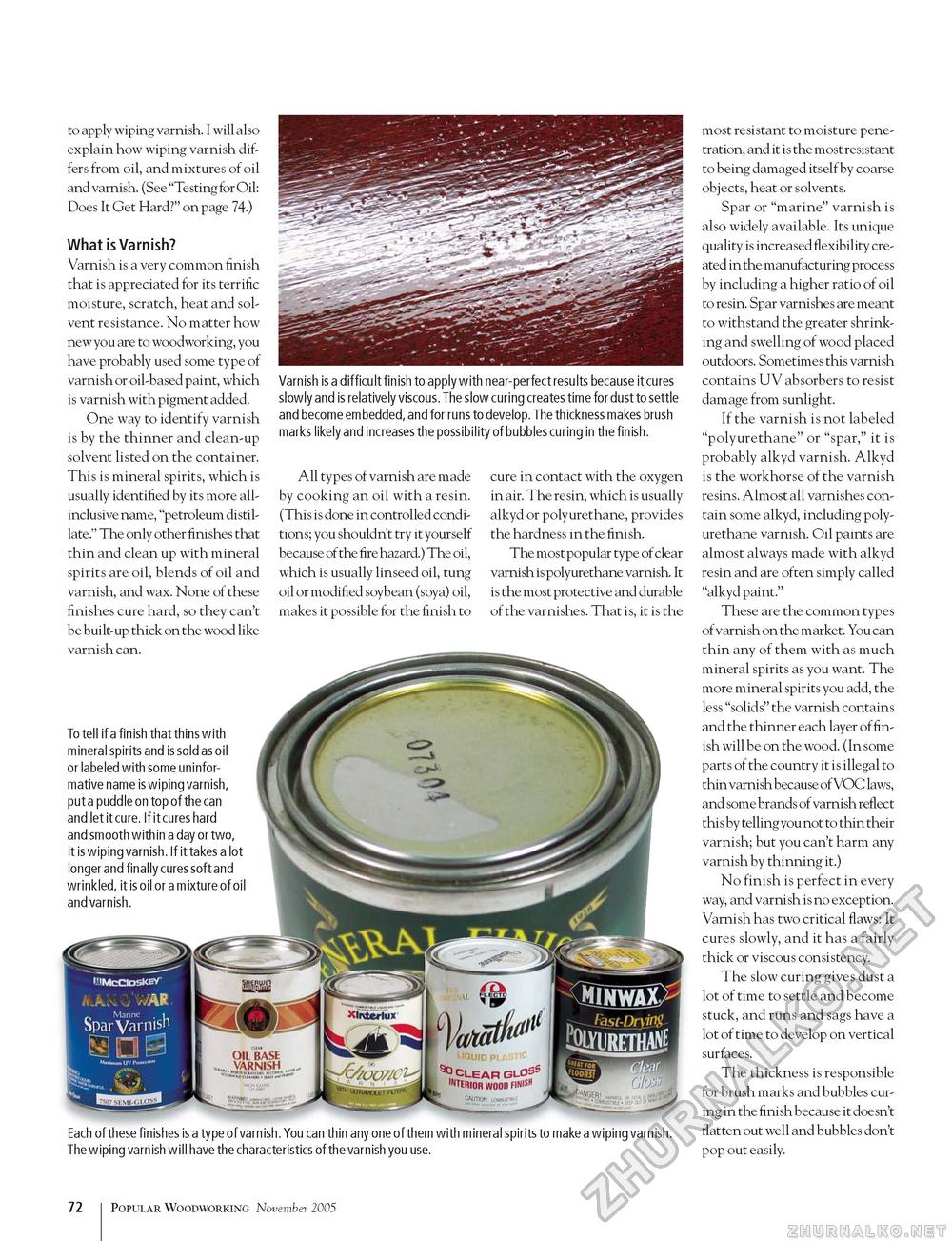Popular Woodworking 2005-11 № 151, страница 75
Varnish is a difficult finish to apply with near-perfect results because it cures slowly and is relatively viscous. The slow curing creates time for dust to settle and become embedded, and for runs to develop. The thickness makes brush marks likely and increases the possibility of bubbles curing in the finish. to apply wiping varnish. I will also explain how wiping varnish differs from oil, and mixtures of oil and varnish. (See "Testing for Oil: Does It Get Hard?" on page 74.) What is Varnish? Varnish is a very common finish that is appreciated for its terrific moisture, scratch, heat and solvent resistance. No matter how new you are to woodworking, you have probably used some type of varnish or oil-based paint, which is varnish with pigment added. One way to identify varnish is by the thinner and clean-up solvent listed on the container. This is mineral spirits, which is usually identified by its more all-inclusive name, "petroleum distillate." The only other finishes that thin and clean up with mineral spirits are oil, blends of oil and varnish, and wax. None of these finishes cure hard, so they can't be built-up thick on the wood like varnish can. All types of varnish are made by cooking an oil with a resin. (This is done in controlled conditions; you shouldn't try it yourself because of the fire hazard.) The oil, which is usually linseed oil, tung oil or modified soybean (soya) oil, makes it possible for the finish to cure in contact with the oxygen in air. The resin, which is usually alkyd or polyurethane, provides the hardness in the finish. The most popular type of clear varnish is polyurethane varnish. It is the most protective and durable of the varnishes. That is, it is the most resistant to moisture penetration, and it is the most resistant to being damaged itself by coarse objects, heat or solvents. Spar or "marine" varnish is also widely available. Its unique quality is increased flexibility created in the manufacturing process by including a higher ratio of oil to resin. Spar varnishes are meant to withstand the greater shrinking and swelling of wood placed outdoors. Sometimes this varnish contains UV absorbers to resist damage from sunlight. If the varnish is not labeled "polyurethane" or "spar," it is probably alkyd varnish. Alkyd is the workhorse of the varnish resins. Almost all varnishes contain some alkyd, including poly-urethane varnish. Oil paints are almost always made with alkyd resin and are often simply called "alkyd paint." These are the common types of varnish on the market. You can thin any of them with as much mineral spirits as you want. The more mineral spirits you add, the less "solids" the varnish contains and the thinner each layer of finish will be on the wood. (In some parts of the country it is illegal to thin varnish because of VOC laws, and some brands of varnish reflect this by telling you not to thin their varnish; but you can't harm any varnish by thinning it.) No finish is perfect in every way, and varnish is no exception. Varnish has two critical flaws: It cures slowly, and it has a fairly thick or viscous consistency. The slow curing gives dust a lot of time to settle and become stuck, and runs and sags have a lot of time to develop on vertical surfaces. The thickness is responsible for brush marks and bubbles curing in the finish because it doesn't flatten out well and bubbles don't pop out easily. To tell if a finish that thins with mineral spirits and is sold as oil or labeled with some uninfor-mative name is wiping varnish, put a puddle on top of the can and let it cure. If it cures hard and smooth within a day or two, it is wiping varnish. If it takes a lot longer and finally cures soft and wrinkled, it is oil or a mixture of oil and varnish. Each of these finishes is a type of varnish. You can thin any one of them with mineral spirits to make a wiping varnish. The wiping varnish will have the characteristics of the varnish you use. 72 Popular Woodworking November 2005 |








